Kutz M. Handbook of materials selection
Подождите немного. Документ загружается.

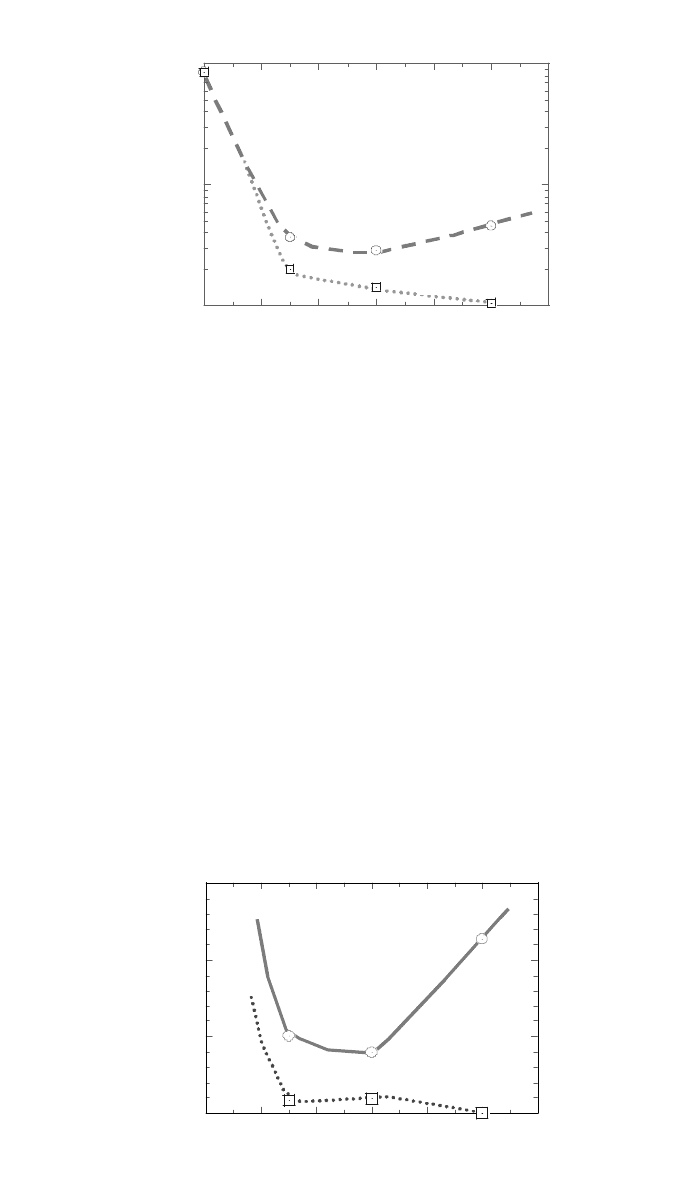
3 PRODUCT DEVELOPMENT FUNDAMENTAL FACTORS 1209
10
1
10
2
10
3
0 20 40 60 80 100 120
Dos (k Gy)
E-Beam
Gamma
HD 180°C OIT (min)
Fig. 13 Comparison of gamma and E-beam irradiation on OIT of MDPE.
0
10
20
30
020
40
60 80 100 120
Dose (k Gy)
Control = 180 min.
E-Beam
Gamma
180°C OIT (min)
Fig. 14 Comparison of gamma and E-beam on OIT of PP.
This significant reduction in OIT stability was also seen in Fig. 13 in the E-
beam samples at 30 kGy, although a slightly better retention of antioxidants is
seen with the E-beam. At 30 kGy, the E-beam has about 40 min on OIT as
compared with 20 min for gamma. From 60 to 100 kGy in E-beam, a distinct
upturn in OIT is plainly evident. This upturn is most likely caused by thermal
and exposure time effects under high dose rates from limited oxygen availability
and accelerated free radical termination reactions favored at higher temperatures.
For the PP sample, a drastic OIT reduction is evident again, with even greater
depletion ratios under gamma irradiation in Fig. 14. Once more, the OIT upturn
at higher dose rates are very pronounced under E-beam. Most likely, similar
dose-rate-related exposure time and thermal effects are the causes.
The significant departure toward greater overall stability and the upturn at
100 kGy could be rationalized by the extremely high dose rate and the resulting
temperature rise. At these high doses, E-beam dose rates of over 200 kGy per
second or 720,000 kGy per hour are encountered, or about four orders of mag-
nitude higher than that of the gamma irradiation. In terms of the irradiation time,
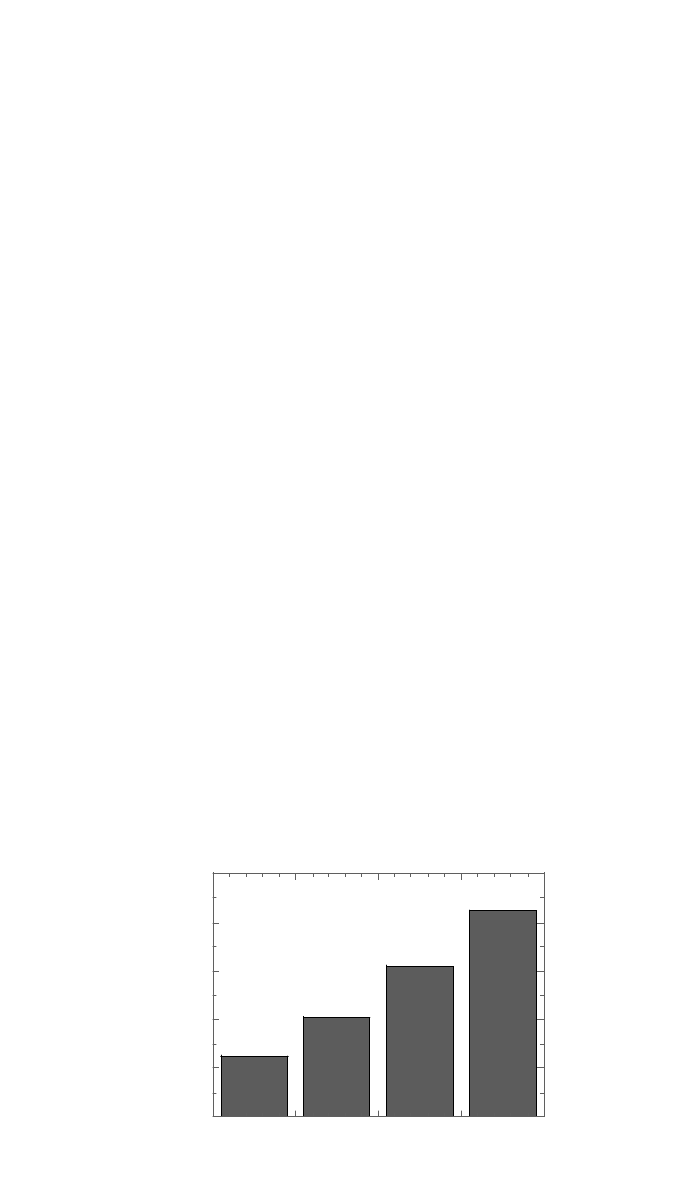
1210 SELECTING MATERIALS FOR MEDICAL PRODUCTS
0
20
40
60
80
100
03060100
Dose (k Gy)
Cp= 1.7 J / C
T (°C) Adiabatic
Fig. 15 PP temperatures rise at different E-beam doses.
instead of nearly 17 h for 100 kGy, it would take 0.5 s for the E-beam. These
high dose rates would invariably lead to much higher free radical concentrations
during the exposure and much higher recombination reactions discussed earlier.
Using a standard specific heat at room temperature of 1.7 J/
⬚C for PP, and
assuming no heat loss (adiabatic), temperature rises for PP are shown in Fig.
15. It is seen that partricularly for 100 kGy, a temperature over 85
⬚C is reached.
At the higher temperatures, the free radical recombination and termination re-
action is expected to be much faster than at near 25
⬚C. Less antioxidant con-
sumption and less polymer degradation are predictable. The potential side effect
of hihger dose rate by E-beam could be surface cosmetic defects on medical
devices due to fast melt and cooling.
The E-beam results suggest medical device and medication delivery system
made from PP materials could be E-beam sterilized. The concerns of castrophic
failure could be minimized. The OIT indicates that PP has much better thermal
stability at the high dosage of E-beam sterilization. This recommendation, how-
ever, still requires the confirmation from real-time sample testing, particularly
with medical products for up to 2 years of product shelf life.
3.3 Newly Commercially Available Polyolefin-Based Materials
Recent progress in metallocene technology, including the ability to produce in-
expensive metallocene catalysts, has led to the development of cost-effective
metallocene-based polyolefin and cyclo-olefin materials. Metallocene polyolefins
have the potential to achieve much better performance than existing PE and PP
formulations. Cyclo-olefin materials give a high clarity for medical applications.
Because they have properties similar to many specialty polymers and engineer-
ing plastics, metallocene polyolefins have the potential to replace PVC and some
expensive engineering plastics, particularly for medical products requiring high
clarity and impact strength and ductility at low temperatures. As a result, this
polyolefin family is showing great potential for use in the medical and health-
care products industries.
The materials used by most of medical device and solution drug delivery
systems today are still dominated by PVC materials. To be useful in medical

3 PRODUCT DEVELOPMENT FUNDAMENTAL FACTORS 1211
products, however, metallocene-based polyolefins must also fulfill product de-
sign, processing, and performance requirements simultaneously. To meet these
criteria with high product quality at the lowest possible cost, it will require a
broad spectrum of material characteristics and processing capabilities.
PVC versus Metallocene-Based Polyolefins
Device manufacturers that wish to consider the use of metallocene polyolefins
for use in medical devices or medical packaging will need to look at a wide
range of characteristics. While the major traits of PVC have been established
through a long history of use, those related to metallocenes are still emerging
as the technologies develop and improve. Following are some of the key advan-
tages and disadvantages of each, as their respective technologies now stand.
Advantages of PVC. Polyvinyl chloride can be used to produce a variety
of medical products ranging from rigid components to flexible sheeting. The
type and amount of plasticizer used determine the compound’s glass transition
temperature (T
g
), which in turn defines its flexibility and low-temperature char-
acteristics and thereby establishes its range of suitable applications.
Because rigid and flexible PVC components have the same material structure,
they can be easily assembled by solvent bond. The two solvents most commonly
used in PVC bonding are cyclohexanone and methyl ethyl ketone (MEK). Rigid
parts that have been molded of PVC are suitable for ultrasonic bonding, while
flexible extruded or calendered PVC films can be sealed using heat or radio-
frequency (RF) sealing.
Medical products made from PVC can be sterilized by steam, ethylene oxide,
or gamma radiation. Plasticized PVC can have a T
g
as low as ⫺40⬚C and still
be suitable for steam sterilization at 121
⬚C. Additional characteristics that make
PVC attractive include its low cost, broad T
g
spectrum, wide processing tem-
perature range, high seal strength, thermoplastic elastomer-like material prop-
erties, high transparency, wide range of gas permeability, and biocompatibility.
Medical products made from PVC have passed critical toxicological, biological,
and physiological testing. In sum, PVC is one of the best medical materials in
terms of cost and function. No other single material has such broad material
latitude.
Disadvantages of PVC. Even though many medical products have been
made from PVC, the material continues to receive criticism.
14
The most com-
monly cited shortcomings involve toxic effluents produced during manufacture
and the generation of hydrogen chloride (HCl) during incineration. Because HCl
is a component of acid rain, postuse disposal costs for incinerating PVC can be
quite high. Other concerns related to PVC depend largely on the type and amount
of plasticizers used. For some PVC compounds, there is evidence of plasticizer
leaching to medical solutions, chemical interaction with drugs, water vapor loss
during long-term storage of medical solutions, and gas permeability.
Although these disadvantages sound challenging, most can be eliminated or
managed using existing technologies. For instance, current PVC manufacturing
techniques can reduce residual vinyl chloride monomer levels to less than 1
ppm, thus minimizing the toxic effects of the compound. Similarly, modern
emission-scrubbing equipment can adequately prevent releases of HCl and other

1212 SELECTING MATERIALS FOR MEDICAL PRODUCTS
effluents during incineration disposal. On the other hand, di-2-ethyl-hexyl phthal-
ate (DEHP) is known to enhance red blood cell (RBC) membrane stability that
prevents RBC from rapture.
With regard to the leaching of the plasticizer DEHP, however, expert opinion
remains divided. California’s Safe Drinking Water and Toxic Enforcement Act
of 1986 raised concerns about the toxicity of DEHP. But a long-term hemodi-
alysis study that covered more than 7 billion patient-days of exposure resulted
in no widely accepted data linking DEHP exposure to carcinogenicity in human
beings.
15
Advantages of Metallocenes. The revolution in polyolefin materials spurred
by new metallocene catalyst technologies has created a great opportunity for
medical and health-care industries. High yield, high clarity, high impact resis-
tance, and low extractables are just a few useful characteristics of this plasticizer-
free polyolefin family.
Metallocene PP is one group of compounds for which research has shown
great potential.
16–17
Unprecedented control over the microstructure of PP has led
to commercial production of syndiotactic PP (s-PP); material scientists are also
exploring new elastomeric PP using oscillating catalysts.
18
The material prop-
erties of these two new PPs are similar to those of thermoplastic elastomers
(TPEs), particularly the oscillating catalyst compound, which requires only a
propylene monomer. This is different from current commercial PP elastomers
that are based on the monomer C3 but have C2 and C4 as comonomers.
Moreover, metallocene-based cyclo-olefin has been tested for medical syringe
applications. The cyclo-olefin materials possess a high clarity for solution drug
prefilled syringes that is easy for visual inspection.
Metallocene PE (m-PE), on the other hand, has been targeted for use as a
film in the medical container and packaging industry.
19–20
Enhanced clarity and
reductions in both initial seal temperature and crystallinity certainly create many
advantages for the medical industry. Metallocene PE is also expanding into med-
ical packaging applications traditionally dominated by ethylene-propylene-diene
monomer and ethylene-propylene rubber.
There are a number of other characteristics that make metallocene-based po-
lyolefins attractive for use in the medical industry. Most important, the TPE-like
materials are chemically inert and do not interact with drugs. Their narrow mo-
lecular weight distribution (MWD) results in low leaching and extractable levels,
and their high thermal stability minimizes the need for stabilizers. The materials
accommodate gamma radiation, and impact-resistant s-PP film tolerates steam
sterilization. Lastly, the compounds are environmentally sound and can be
cleanly incinerated or recycled, thereby reducing disposal costs.
Potential Metallocene Disadvantages. The current formulations of metal-
locenes have a number of disadvantages that researchers may in time overcome.
For instance, concern over metal residues makes researchers’ efforts to reduce
the use of the cocatalyst methylaluminoxane (MAO) a matter of some urgency.
Fortunately, some of newly commercially available m-PE have significantly re-
duced cocatalyst levels. The usefulness of some formulations may also be limited
by processing concerns: Because of its narrow MWD and long cystallization
half-time, for instance, s-PP is difficult to process.

4 MANUFACTURING PROCESS ON MATERIALS PROPERTIES 1213
Sealing presents another difficulty. Metallocene polyolefins are suitable for
heat sealing but not for solvent bonding or RF sealing, which are required steps
in assembling medical device kits. Similarly, metallocene PE can not be auto-
claved because of its low melting point (T
m
). Finally, metallocene technology
must still confront the key challenge of cost reduction to meet market constraints.
Although their potential is great, metallocene polyolefins will have to overcome
a number of challenges before they gain wide acceptance in the medical and
health-care industries. These include concerns in the areas of product safety and
resin quality, product design and processing, and product performance.
3.4 Manufacturing Process
In the medical industry, it often takes great efforts and long cycle time to qualify
new polymeric materials and to validate their downstream manufacturing pro-
cesses before products reach the market. It is well understood that the quality
and cost of the medical products depend heavily on the manufacturing processes.
From medical manufacturing viewpoints, it is highly desirable to extend the
applications of the approved materials to other developing products. This strat-
egy can be achieved by maximizing material properties through an expanding
process window to fulfill product performance requirements. Better quality, high
throughput rate, less development time, and cost-effective products can be
achieved if the manufacturing processes are optimized. Some examples of man-
ufacturing process related material properties and product performance are dis-
cussed next.
4 MANUFACTURING PROCESS ON MATERIALS PROPERTIES
Polymeric materials suitable for medical application have passed toxicology and
biological testing. Medical manufacturers always like to extend the approved
materials to other product lines if the existing materials have potential to meet
the product requirements. Moreover, the physical properties of materials can vary
with the manufacturing processing, such as extrusion, injection molding, and
compression molding. For example, the optical properties of sheeting materials,
such as haze, gloss, yellowness index (YI), and gel imperfection, can be manip-
ulated by extrusion processing conductions. Some examples are discussed next.
4.1 LLDPE Pelletization Processing on Haze, Gloss, and Gel Counts
The pelletizing conditions of linear low density polyethylene (LLDPE) resin and
its blown extrusion conditions are examined simultaneously to optimize film
properties. Figure 16 shows the effect of pelletization melt temperature on haze
and gloss at a constant throughput rate (18 kg/h). No significant change in haze
and gloss is observed as the pelletization temperature is below 250
⬚C.
However, the gel level in the blown films is significantly affected by the output
rate and melt temperature of the pelletization process. Figure 17 shows the ef-
fects of pelletization melt temperature and output rate at the fixed blown tem-
perature of 202
⬚C. Lower pelletization temperature provides lower gel level. This
might be related to the dispersion of the higher-molecular-weight species. Uni-
form dispersion of the high-molecular-weight species might not be achieved if
the shear force is too low due to a low melt viscosity at the high pelletizing
temperatures.
21
The output rate does not show a consistent trend in the gel level
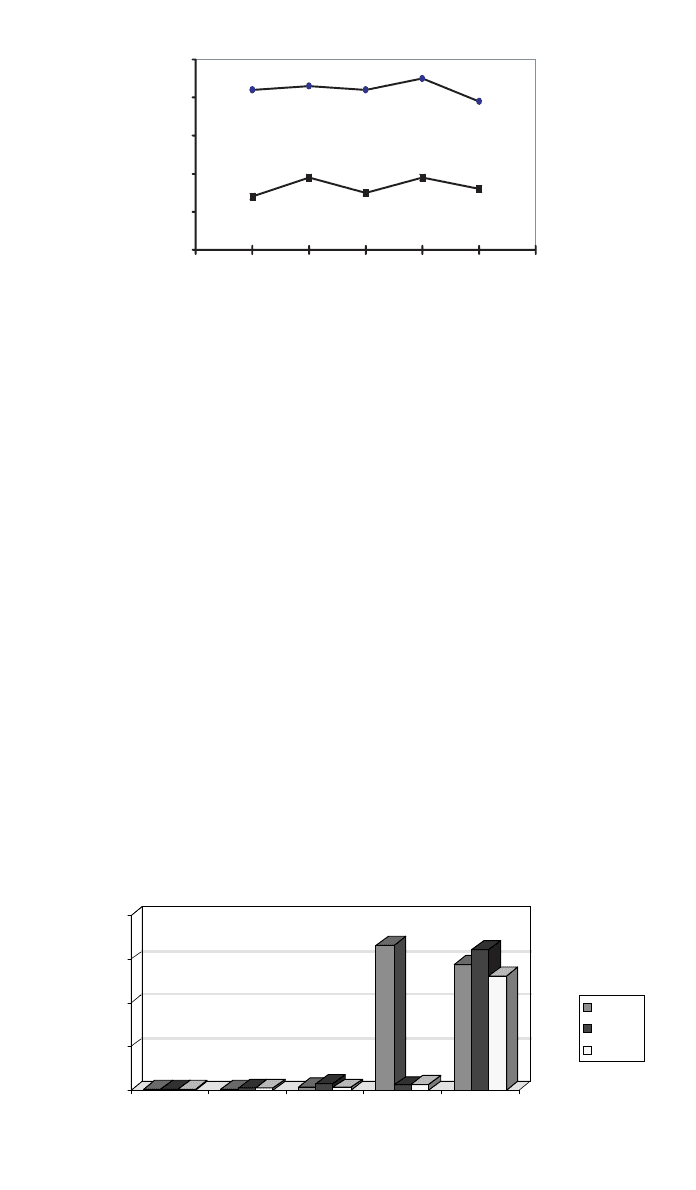
1214 SELECTING MATERIALS FOR MEDICAL PRODUCTS
39
16
45
42
43
42
19
15
19
14
0
10
20
30
40
50
2 0 0 218 232 244 254 265 28 0
Pe l l eti zation Melt Ti me (C)
Haze (%) or Gloss (%)
Ha ze
Gloss
Fig. 16 Haze and gloss of the extruded blown film with different pelletization temperatures.
Killion pelletization line was run at 75 rpm and Collin blown line was run at 202⬚C with
18 kg / h throughput.
0
3000
6000
9000
12000
Total Gel Counts
218-230 231-243 244-253 254-264 265-280
Pelletization Melt Temperature (C)
18 kg/hr
27 kg/hr
37 kg/hr
Fig. 17 Total gel count of LLDPE blown films, a different pelletization melt
temperature, and different output rates.
of the blown films in Fig. 17. Although, higher shear stresses are provided at
higher output rates, high screw speeds could also pass the nondispersed gels
through the pelletizing process and result in an initially high gel count in the
blown films. The gel level drops dramatically as the pelletization melt temper-
ature decreases to 244–255
⬚C, regardless of the throughput rate of pelletization.
4.2 LLDPE Blown-Film Processing on Mechanical, Haze, Gloss, and
Gel Counts
Table 5 shows the data of the selected film properties obtained from the extrusion
of LLDPE on the blown-film line at isothermal 190, 218, and 246
⬚C temperature
profiles. Ultimate tensile strengths on both machine and transverse directions
are reduced at a higher blown temperature. This implies less orientation imparted
to the blown films on both machine and transverse directions at a higher blown
temperature. The higher blown temperature does essentially no harm to the me-
chanical properties of the films. The gel level remains at the same level, regard-
less of change in the blown film melt temperature. From the above study, we
conclude that the gel level is only affected by pelletizing temperatures.
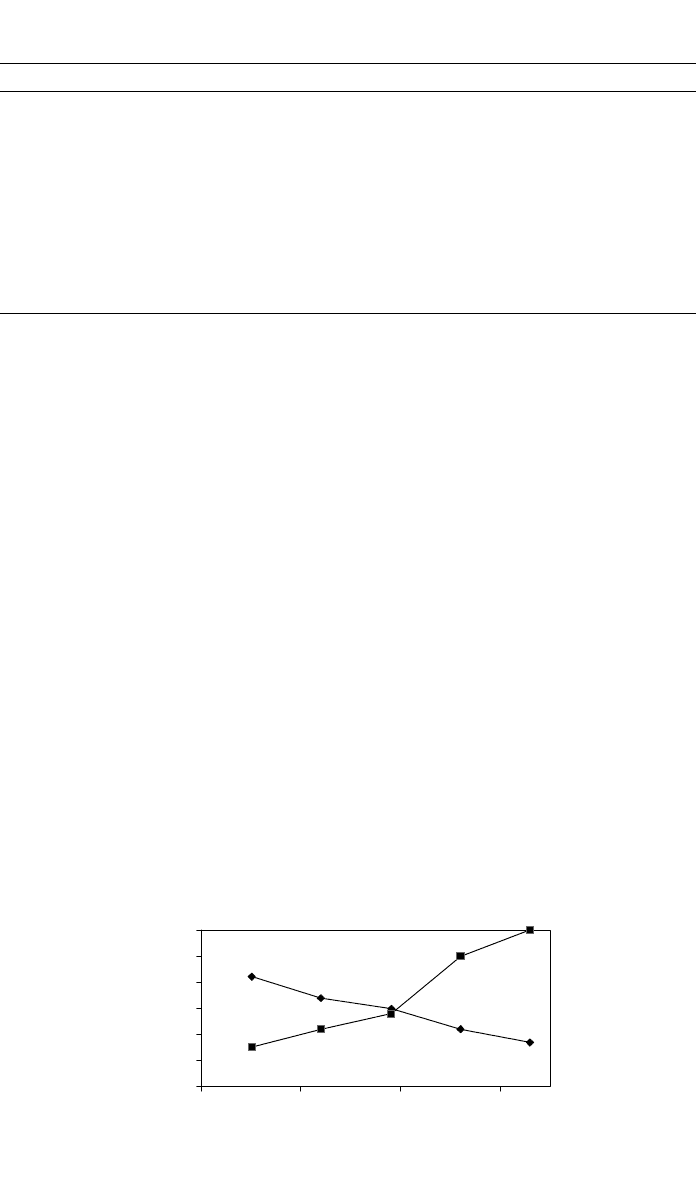
4 MANUFACTURING PROCESS ON MATERIALS PROPERTIES 1215
Table 5 Effect of Blown Extrusion Temperature on LLDPE Film Properties
Blown Film Temperature Profile 190⬚C Profile 218⬚C Profile 246⬚C Profile
Haze (%) 57.5 45.8 16.8
Gloss (%) 7.6 15.6 62.6
Ultimate tensile strength (MPa) MD / TD 58 / 50 58 / 48 42/ 46
Ultimate tensile elongation (%) MD / TD 902 / 1002 860 / 960 840 / 950
Elemendorf tear (g) MD / TD 3.3 / 4.8 3.4 / 4.8 3.5 / 4.5
Gel counts
0.2–0.5 mm 68 50 70
0.51–0.7 mm 4 2 2
0.71–1.5 mm 0 0 0
⬎1.5 mm 0 0 0
MD ⫽ machine direction.
TD
⫽ traverse direction.
0
10
20
30
40
50
60
180 200 220 240
Blown Extrusion Temperature (C)
Haze (%) or Gloss (%)
Haze Gloss
Fig. 18 Haze and gloss on LLDPE blown films with different blown extrusion temperatures.
Figure 18 shows the haze of the films processed at different blown-film melt
temperatures. The haze decreases from 42 to 17% as the blown temperature
increases from 190 to 246
⬚C. Reduction of haze with increasing blowing film
temperature can be related to the mechanical deformation of the melt that re-
duces both melt elasticity and haze. Studies
22
on blown LDPE films suggested
that the haze observed in blown-film operations was from melt flow disturbances
on the film surfaces at the die exit and crystallization in both surface and bulk.
The surface haze moiety or surface roughness from melt flow disturbances could
be minimized by reducing melt elasticity through ‘‘shear refining’’ or higher
melt temperatures.
23
In Fig. 18, gloss of the blown films increases from 15 to
60% as the blown extrusion temperature increases from 190 to 246
⬚C. Gloss has
an inverse relationship with surface roughness.
24
It is believed that the surface
roughness of the LLDPE blown films is reduced at a higher blown extrusion
temperature just like the responses from the study of low-density polyethelene
(LDPE) films.
18
Therefore, an ideal LLDPE film with fewer gels, lower haze,
and higher gloss can be obtained by pelletizing the resin at a low-temperature
profile, and then blown extruding the pellets at a higher temperature profile.
However, the potential challenges could be extrusion stability due to low vis-
cosity from high-temperature extrusions.
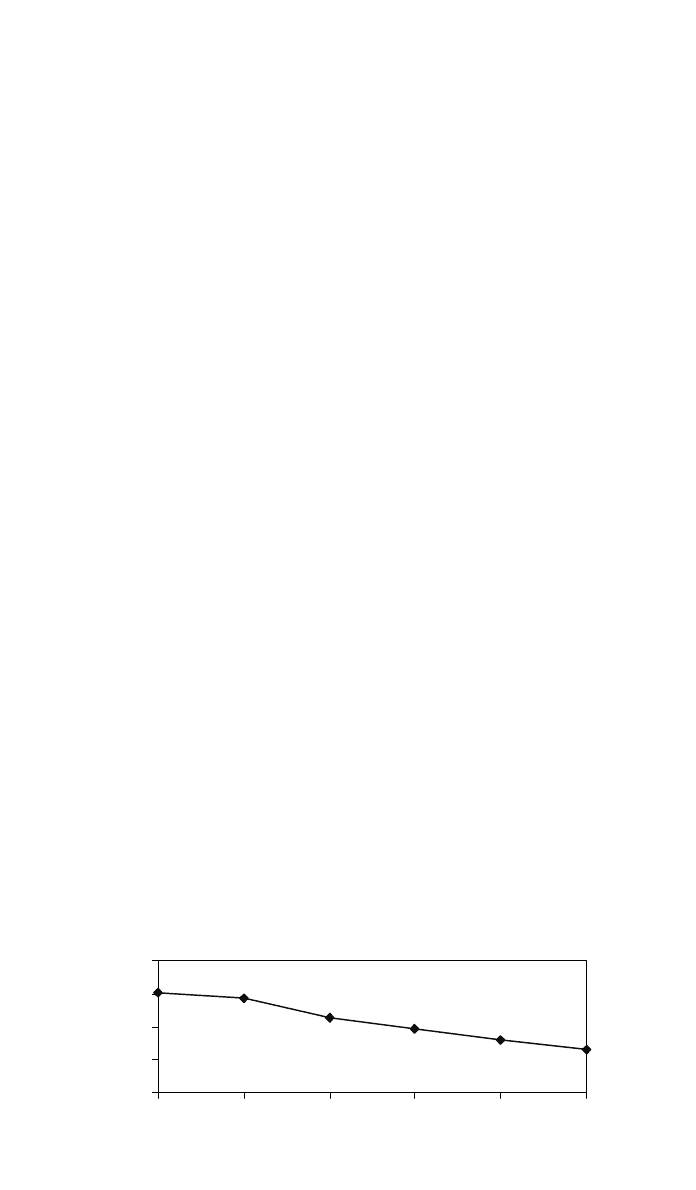
1216 SELECTING MATERIALS FOR MEDICAL PRODUCTS
1000
1500
2000
2500
3000
75.00%80.00%85.00%90.00%95.00%100.00%
30 MI Secondary m -ULDPE
Melt Pressure (psi)
Fig. 19 Melt pressure of 1.0 MI (primary) and 30 MI (secondary) m-ULDPE blends.
4.3 Metallocene ULDPE Tubing Extrusion Throughput Rate
Improvement
Metallocene polyolefins have narrower molecular weight distribution (MWD)
than their corresponding Ziegler–Natta polyolefins due to their catalyst charac-
teristics. Lack of lower-molecular-weight species for a metallocene polyolefin
generates manufacturing challenges, such as shark-skin appearance and lower
throughput rate. It is desirable to maintain the superior material properties of
metallocene polyolefins and improve their extrusion processes by broadening
their MWD. Blending a minor amount of a second polyolefin is commonly used
to broaden the MWD of a metallocene polyolefin.
As we process the metallocene-ultra low density polyethylene (m-ULDPE)
resins, the melt pressures become higher as throughput approachs their maxi-
mum at a given processing condition. The melt pressure can be reduced by
introducing a thixotropic species, such as a lubricant or the other polyolefins
with lower molecular weight. Several secondary polyolefins are blended with
the base m-ULDPE to address this challenge. Melt pressure becomes a suitable
indicator for throughput enhancement in the tubing extrusion process. A lower
melt pressure generally yields a higher extrusion rate.
Figure 19 shows the melt pressure of 1.0 melt index (MI) m-ULDPE tubing
extrusion, which gradually drops as the weight percentage of 30 MI m-ULDPE
increases. The melt pressure decreases to its original 65% level as the 30 MI
resin increases to 25% of the blend. The same resin blend has been run in the
commercial-scale extruder and the throughput rate was noted to double that of
the base resin. It is believed that 30 MI m-ULLDPE resin enhances the extrusion
throughput by broadening the MWD, in addition to its lubricant effect.
The throughput rate increased through the blending approach is also con-
firmed by the other secondary 18 MI m-ULDPE. Figure 20 shows a similar trend
with a slightly less throughput rate increase than 30 MI. This suggests that with
similar molecular structure, the secondary resin with a higher MI acts like an
effective lubricant that changes the rheological properties of the melt.
Figure 21 shows the extrusion melt pressure of the same base resin that is
blended with a 20 MI LDPE resin. A similar trend of extrusion melt pressure
is observed as the percent of LDPE increases. The melt pressure of the blend
with 25% LDPE decreases to 70% of its original value. LDPE is generally
known as a broad MWD resin that is easy for common extrusion processing. It

4 MANUFACTURING PROCESS ON MATERIALS PROPERTIES 1217
1000
1500
2000
2500
3000
75.00%80.00%85.00%90.00%95.00%100.00%
18 MI Secondar
y
m-ULDPE
Melt Pressure (psi)
Fig. 20 Melt pressure of 1.0 MI (primary) and 18 MI (secondary) m-ULDPE blends.
1000
1500
2000
2500
3000
75.00%80.00%85.00%90.00%95.00%100.00%
20 MI Secondary LDPE
Melt Pressure (psi)
Fig. 21 Melt pressure of 1.0 MI m-ULDPE and 20 MI LDPE blends.
is believed that the effect of broadening MWD by LDPE is similar to that by
high MI m-ULDPEs.
It is interesting to note in Fig. 22 that a 3.6 MI Ziegler–Natta ULDPE resin
does not achieve the similar result. Throughput rate of the blends does not
increase even if the composition of the secondary resin increases to 25%. It
suggests that broadening the MWD alone is not enough to lower the extrusion
melt pressure. The rheological properties of the secondary resin also play major
roles in improving the extrusion throughput rate. A typical rheological indicator,
such as melt index (MI) number, can be used for this purpose. For the tubing
extrusion of 1.0 MI m-ULDPE, an ideal extrusion throughput rate relies on
higher MI of the secondary ULDPE or LDPE resins.
4.4 PP Injection-Molding Processing on Medical Product Clarity
The effect of molding temperature on the clarity of medical products made from
PP pellets is shown in Fig. 23. Plaques were molded at different temperatures
from the pellets having identical melt flow rate and additive packaging, but
various catalyst systems. As the injection temperature varied from 184 to 232
⬚C,
the YI of the first sample decreased from 10 to 1.0, and that of the second
sample from 5.7 to 3.1. This decrease in YI, or improved clarity, that takes place
as the temperature increase can be related to resin morphology changes brought
on by fast quench from high molding temperatures.
25
In general, the YI of medical PP suitable for medical product applications is
typically expected to be less than 8.0. The variation in YI with molding tem-
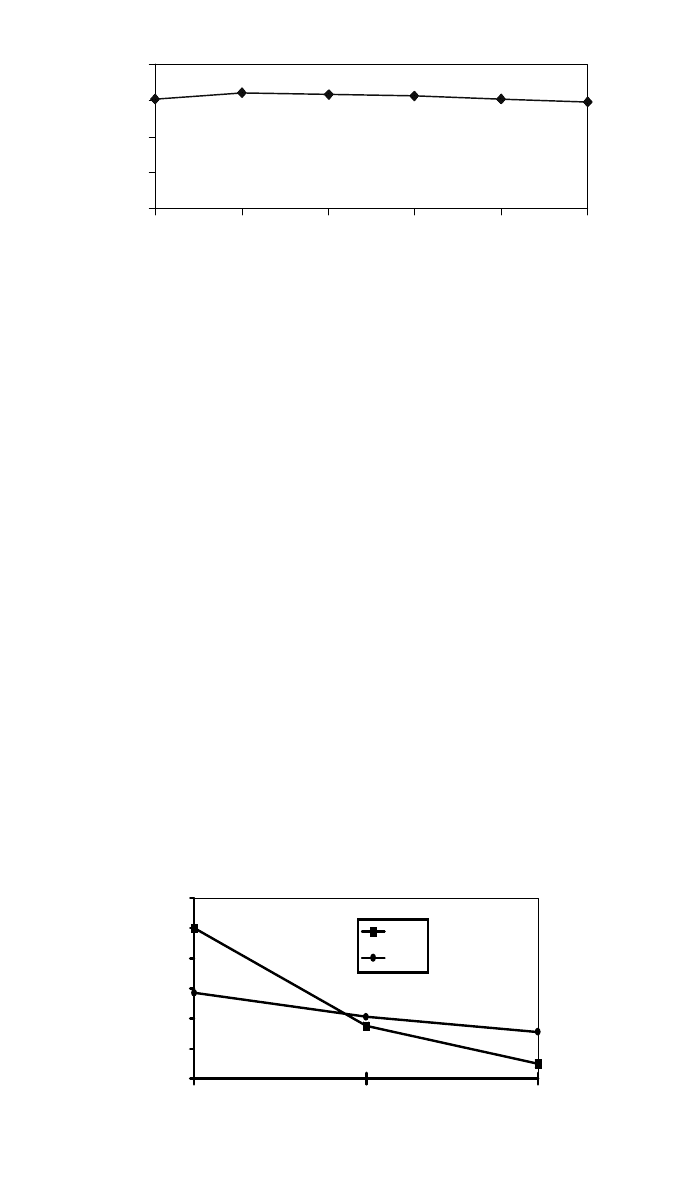
1218 SELECTING MATERIALS FOR MEDICAL PRODUCTS
1000
1500
2000
2500
3000
75.00%80.00%85.00%90.00%95.00%100.00%
3.6 MI Secondary ZN-ULDPE
Melt Pressure (psi)
Fig. 22 Melt pressure of 1. O MI m-ULDP and 3. 6 MI ZN ULDPO blends.
10
3.5
1
5.7
4.1
3.1
0
2
4
6
8
10
12
184°C204°C232°C
Injection Molding Temperatures
Yellowness Index (YI)
SX-1
SX-2
Fig. 23 Clarity of PP pellets improves (YI↓) as injection-molding temperature increases.
perature for different pellets reflects the different catalyst systems used to pol-
ymerize the PP flakes. The various levels of catalyst residues introduce different
lamellae structures during the cooling process, which in turn results in various
degrees of YI reduction.
Figure 24 shows that the YI of plaques molded of PP flakes was essentially
independent of the injection-molding temperature. The plaques were molded
from flakes that had been pelletized without any additives. Figure 24 indicates
that the catalyst residue alone does not cause PP flakes to change in clarity as
molding temperature increases. However, the previously mentioned differences
in YI between samples when the additives were involved suggest that the metal
residues interact with the additives package, and that the effect of their inter-
action on resin color depends on the molding temperature.
4.5 PP Compression-Molding Processing on Medical Product Clarity
For medical products made by compression molding, temperature again plays a
very important role in influencing clarity. Figure 25 shows that a lower YI was
observed when medical products were compression molded at 246
⬚C versus at
218
⬚C. In addition, longer compression-molding process produced a lower YI,
at both temperatures. PP plaques preheated for 3 min without pressure and fol-
lowed by 1 or 3 min with pressure generally had higher YI values than those
